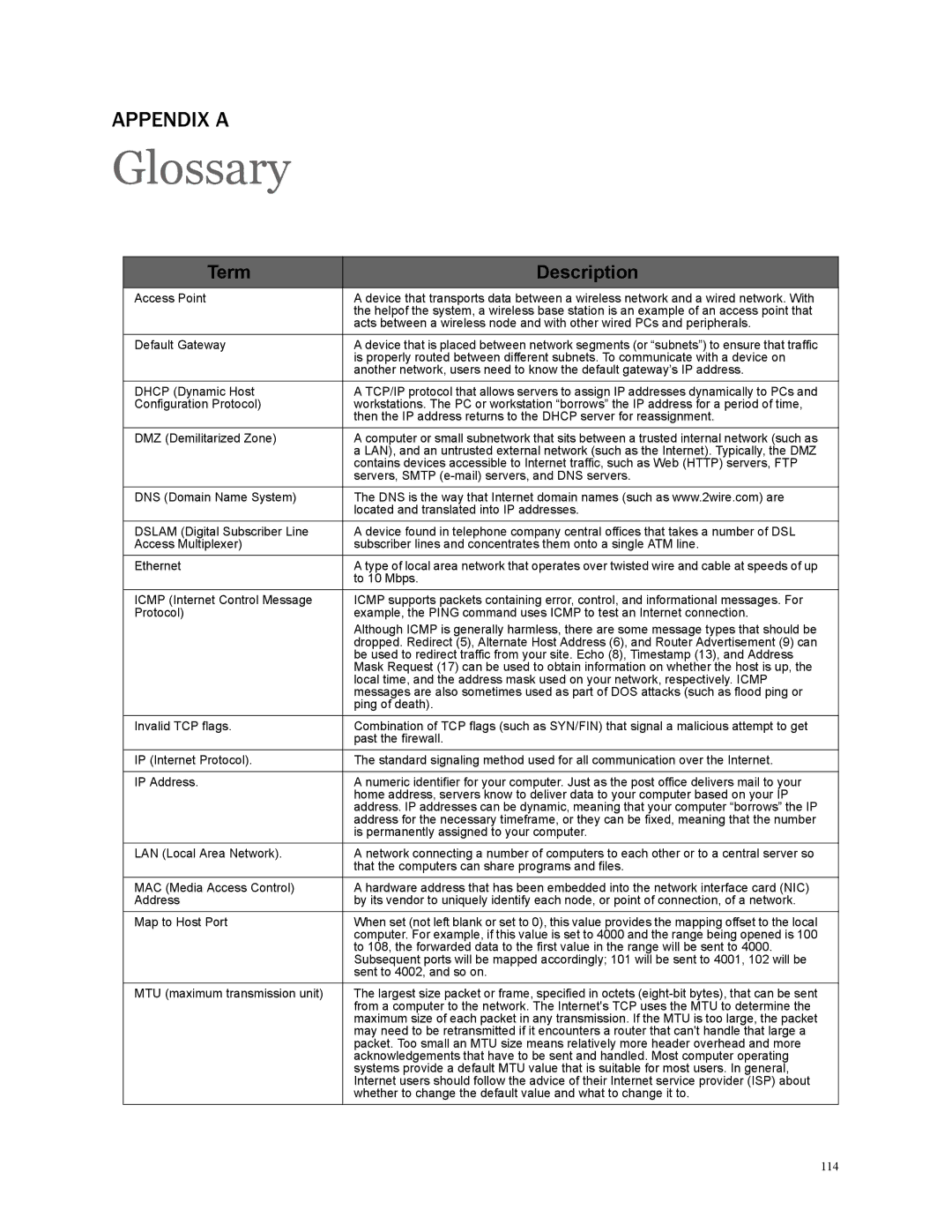APPENDIX A
Glossary
Term | Description |
Access Point | A device that transports data between a wireless network and a wired network. With |
| the helpof the system, a wireless base station is an example of an access point that |
| acts between a wireless node and with other wired PCs and peripherals. |
Default Gateway | A device that is placed between network segments (or “subnets”) to ensure that traffic |
| is properly routed between different subnets. To communicate with a device on |
| another network, users need to know the default gateway’s IP address. |
DHCP (Dynamic Host | A TCP/IP protocol that allows servers to assign IP addresses dynamically to PCs and |
Configuration Protocol) | workstations. The PC or workstation “borrows” the IP address for a period of time, |
| then the IP address returns to the DHCP server for reassignment. |
DMZ (Demilitarized Zone) | A computer or small subnetwork that sits between a trusted internal network (such as |
| a LAN), and an untrusted external network (such as the Internet). Typically, the DMZ |
| contains devices accessible to Internet traffic, such as Web (HTTP) servers, FTP |
| servers, SMTP |
DNS (Domain Name System) | The DNS is the way that Internet domain names (such as www.2wire.com) are |
| located and translated into IP addresses. |
DSLAM (Digital Subscriber Line | A device found in telephone company central offices that takes a number of DSL |
Access Multiplexer) | subscriber lines and concentrates them onto a single ATM line. |
Ethernet | A type of local area network that operates over twisted wire and cable at speeds of up |
| to 10 Mbps. |
ICMP (Internet Control Message | ICMP supports packets containing error, control, and informational messages. For |
Protocol) | example, the PING command uses ICMP to test an Internet connection. |
| Although ICMP is generally harmless, there are some message types that should be |
| dropped. Redirect (5), Alternate Host Address (6), and Router Advertisement (9) can |
| be used to redirect traffic from your site. Echo (8), Timestamp (13), and Address |
| Mask Request (17) can be used to obtain information on whether the host is up, the |
| local time, and the address mask used on your network, respectively. ICMP |
| messages are also sometimes used as part of DOS attacks (such as flood ping or |
| ping of death). |
Invalid TCP flags. | Combination of TCP flags (such as SYN/FIN) that signal a malicious attempt to get |
| past the firewall. |
IP (Internet Protocol). | The standard signaling method used for all communication over the Internet. |
|
|
IP Address. | A numeric identifier for your computer. Just as the post office delivers mail to your |
| home address, servers know to deliver data to your computer based on your IP |
| address. IP addresses can be dynamic, meaning that your computer “borrows” the IP |
| address for the necessary timeframe, or they can be fixed, meaning that the number |
| is permanently assigned to your computer. |
LAN (Local Area Network). | A network connecting a number of computers to each other or to a central server so |
| that the computers can share programs and files. |
MAC (Media Access Control) | A hardware address that has been embedded into the network interface card (NIC) |
Address | by its vendor to uniquely identify each node, or point of connection, of a network. |
Map to Host Port | When set (not left blank or set to 0), this value provides the mapping offset to the local |
| computer. For example, if this value is set to 4000 and the range being opened is 100 |
| to 108, the forwarded data to the first value in the range will be sent to 4000. |
| Subsequent ports will be mapped accordingly; 101 will be sent to 4001, 102 will be |
| sent to 4002, and so on. |
MTU (maximum transmission unit) | The largest size packet or frame, specified in octets |
| from a computer to the network. The Internet's TCP uses the MTU to determine the |
| maximum size of each packet in any transmission. If the MTU is too large, the packet |
| may need to be retransmitted if it encounters a router that can't handle that large a |
| packet. Too small an MTU size means relatively more header overhead and more |
| acknowledgements that have to be sent and handled. Most computer operating |
| systems provide a default MTU value that is suitable for most users. In general, |
| Internet users should follow the advice of their Internet service provider (ISP) about |
| whether to change the default value and what to change it to. |
114
